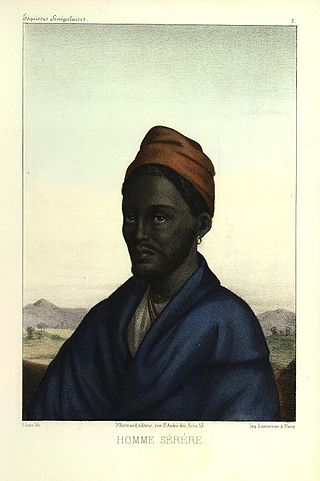Related Research Articles

The West Atlantic languages of West Africa are a major subgroup of the Niger–Congo languages.

Biffeche or Bifeche is an area of Senegal centred on the town of Savoigne, around 30 kilometres north-east of the major coastal city of Saint-Louis.

The Serer-Ndut or Ndut also spelt are an ethnic group in Senegal numbering 38600. They are part of the Serer people who collectively make up the third largest ethnic group in Senegal. The Serer-Ndut live mostly in central Senegal in the district of Mont-Roland, northwest of the city of ancient Thiès.
The Cangin languages[ˈtʃaŋin] are spoken by 200,000 people in a small area east of Dakar, Senegal. They are the languages spoken by the Serer people who do not speak the Serer language (Serer-Sine). Because the people are ethnically Serer, the Cangin languages are commonly thought to be dialects of the Serer language. However, they are not closely related; Serer is closer to Fulani than it is to Cangin.

Senegal is a multilingual country: Ethnologue lists 36 languages, Wolof being the most widely spoken language.
Serer, often broken into differing regional dialects such as Serer-Sine and Serer saloum, is a language of the kingdoms of Sine and Saloum branch of Niger–Congo spoken by 1.2 million people in Senegal and 30,000 in the Gambia as of 2009. It is the principal language of the Serer people.
The Serer people are a West African ethnoreligious group. They are the third-largest ethnic group in Senegal, making up 15% of the Senegalese population. They are also found in northern Gambia and southern Mauritania.

There are various ethnic groups in Senegal, The Wolof according to CIA statistics are the majority ethnic group in Senegal. Many subgroups of those can be further distinguished, based on religion, location and language. According to one 2005 estimate, there are at least twenty distinguishable groups of largely varying size.
Safene (Saafen), Safi or Saafi-Saafi, is the principal Cangin language, spoken by 200,000 people in Senegal. Speakers are heavily concentrated in the area surrounding Dakar, particularly in the Thies Region.
The Serer-Laalaa or Laalaa are part of the Serer ethnic group of Senegambia. They live in Laa, the Léhar Region, which comprises eighteen villages north of Thies and whose inhabitants are Serer-Laalaa. Although the people are ethnically Serer, their language Laalaa is not a dialect of the Serer-Sine language, but—like Saafi, Noon, Ndut and Palor, one of the Cangin languages.
The Serer-Noon also called Noon are an ethnic people who occupy western Senegal. They are part of the Serer people though they do not speak the Serer-Sine language natively.
Noon is a Cangin language of Senegal spoken in the Thiès region. There is an estimated population of 10,000- 50,000 speakers worldwide, rendering this language to be vulnerable. Ethnologue reports that it is 84% cognate with Lehar, essentially a divergent dialect, and 68% cognate with the other Cangin languages.
Beeke is a Bantu language of uncertain affiliation. Guthrie assigned to the Nyali cluster. However, Ethnologue suggests that it may be a divergent form of Bali. It is 65% cognate with Bali, but 38% with the Nyali language Ndaka.
Palor is a language spoken in Senegal. The speakers of this language - the Palor people or Serer-Palor, are ethnically Serers but they do not speak the Serer-Sine language. Like the Lehar, Saafi, Noon and Ndut languages, their language is classified as one of the Cangin languages attached to the Niger–Congo family. Palor is closer to Ndut.
Lehar or Laalaa is one of the Cangin languages spoken in Senegal in the Laa region, north of Thies as well as the Tambacounda area. The speakers are ethnically Serers, however just like the Ndut, Palor, Saafi and Noon languages, they are closely related to each other than to the Serer-Sine language. The Lehar language which is closer to Noon, is part of the Niger–Congo family. The number of speakers based on 2002 figures were 10,925.
The Palors also known as Serer-Palor, among other names, are an ethnic group found in Senegal around the west central, west southwest of Thiès. They are a sub-group of the Serer ethnic group found in Senegal, the Gambia and Mauritania. Although ethnically Serers, they do not speak the Serer language but one of the Cangin languages. Their language is Palor.

The Ndut is a rite of passage as well as a religious education commanded by Serer religion that every Serer must go through once in their lifetime. The Serer people being an ethnoreligious group, the Ndut initiation rite is also linked to Serer culture. From the moment a Serer child is born, education plays a pivotal role throughout their life cycle. The ndut is one of these phases of their life cycle. In Serer society, education lasts a lifetime, from infancy to old age.
Kopé Tiatie Cac is the Supreme Creator in the Serer religion. Kopé Tiatie Cac is the name used by the Ndut people to refer to the Supreme being. Among the Ndut and followers of Serer religion, Kopé Tiatie Cac is associated with death and plague (pisti).
Kokh Kox is the creator god of the Noon people. The Noon are members of the Serer ethnic group of Senegal, the Gambia and Mauritania. Kokh Kox is one of the main deities in Serer religion. The Noon people refer to the supreme being as Kokh Kox rather than Roog, the name the majority of Serers refer to the supreme being in the Serer-Sine language. The name Kokh Kox derives from the deity Koox, the name the Saafi people regularly use to refer to the divine.
The Njuup tradition is a Serer style of music rooted in the Ndut initiation rite, which is a rite of passage that young Serers must go through once in their lifetime as commanded in the Serer religion.
References
- ↑ Ndut at Ethnologue (25th ed., 2022)